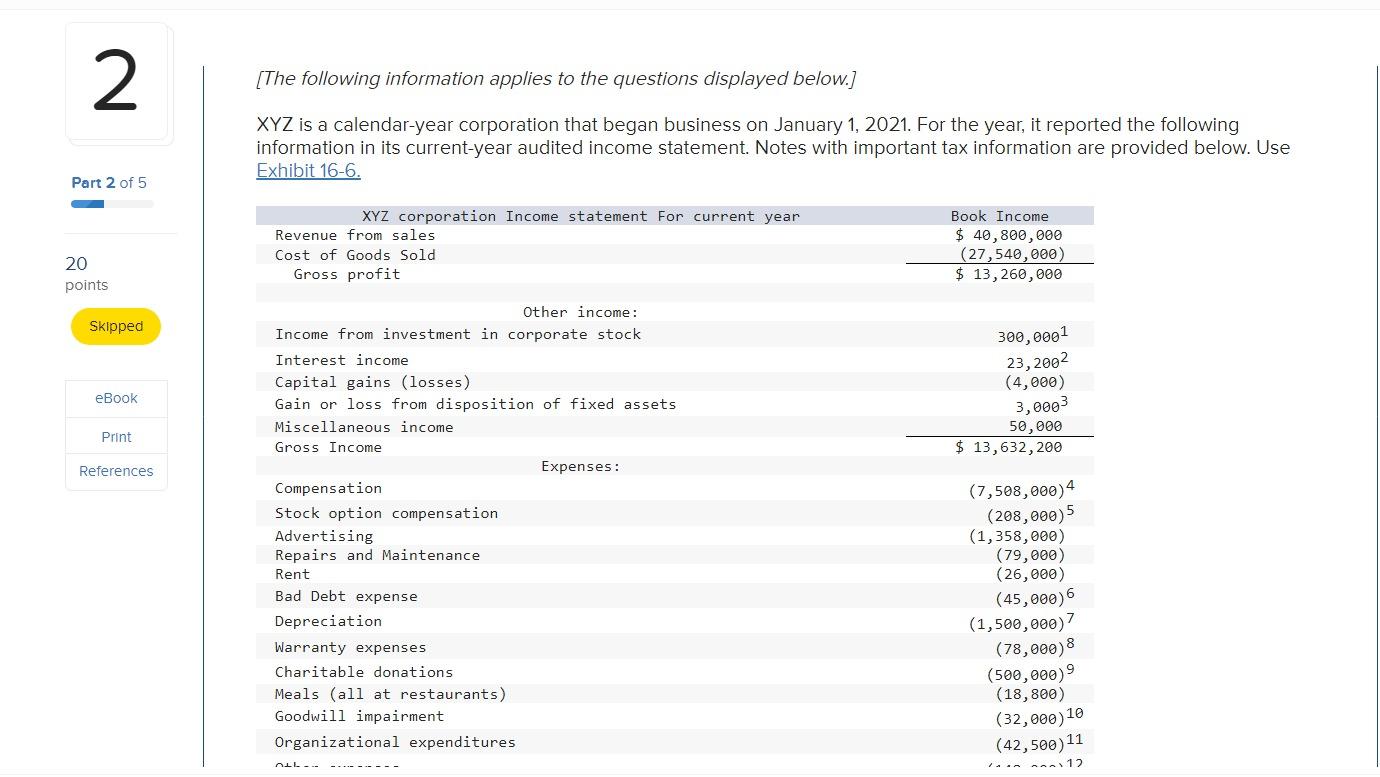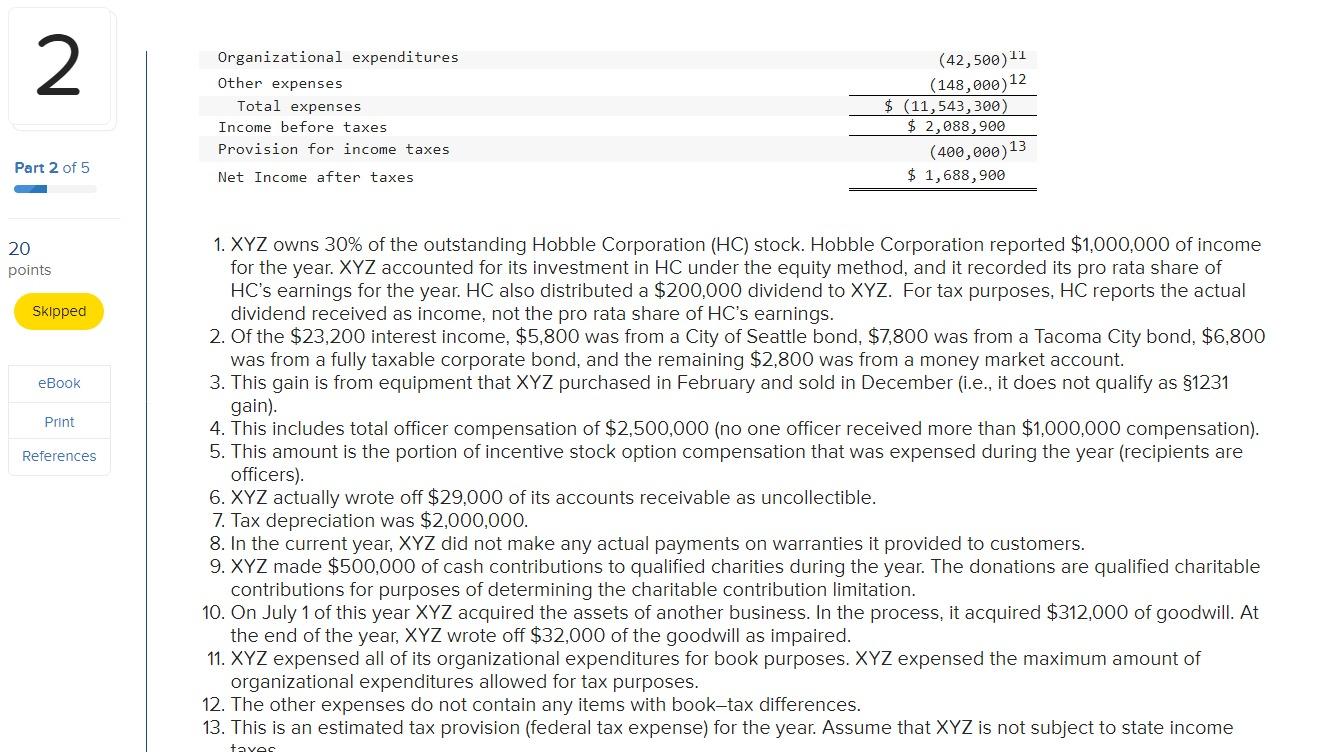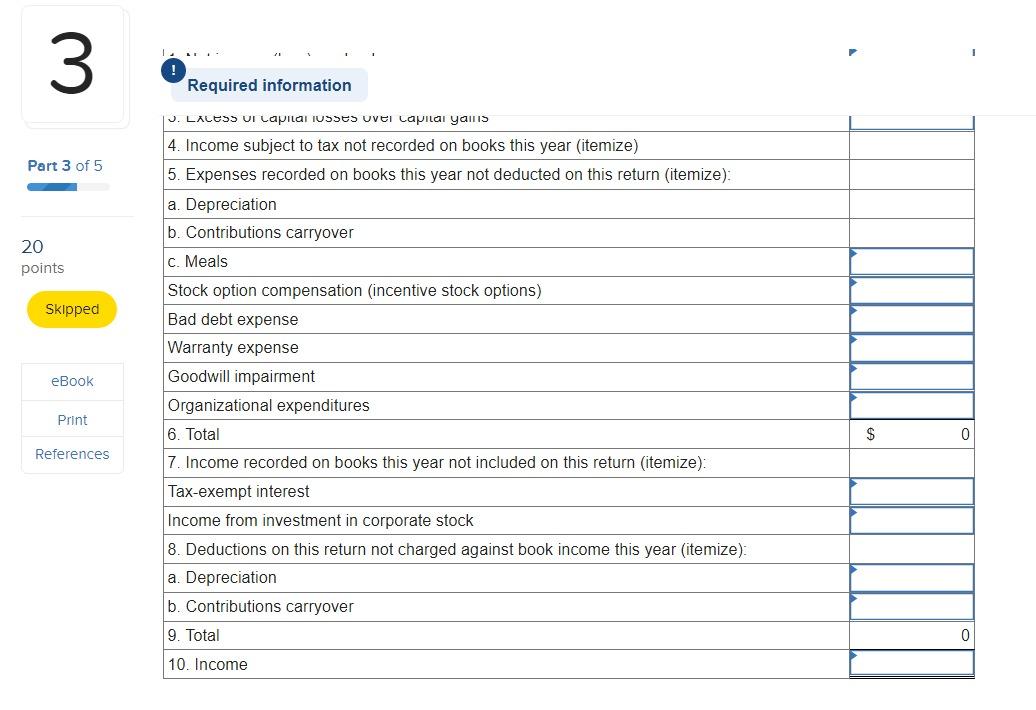I know part of it says "Question 2" but Its the same numbers to be used for question 3. Just didn't want to have to re-screenshot the whole thing again.





2 [The following information applies to the questions displayed below.) XYZ is a calendar-year corporation that began business on January 1, 2021. For the year, it reported the following information in its current-year audited income statement. Notes with important tax information are provided below. Use Exhibit 16-6. Part 2 of 5 XYZ corporation Income statement For current year Revenue from sales Cost of Goods Sold Gross profit Book Income $ 40,800,000 (27,540,000) $ 13,260,000 20 points Skipped 300,0001 23,2002 (4,000) eBook 3,0003 Print 50,000 $ 13,632,200 References Other income: Income from investment in corporate stock Interest income Capital gains (losses) Gain or loss from disposition of fixed assets Miscellaneous income Gross Income Expenses: Compensation Stock option compensation Advertising Repairs and Maintenance Rent Bad Debt expense Depreciation Warranty expenses Charitable donations Meals (all at restaurants) Goodwill impairment Organizational expenditures (7,508,000)4 (208,000)5 (1,358,000) (79,000) (26,000) (45,000)6 (1,500,000) (78,000) (500,000) (18,800) (32,000) 10 (42,500) 11 ALL-- ... 12 2 Organizational expenditures Other expenses Total expenses Income before taxes Provision for income taxes Net Income after taxes (42,500)11 (148,000) ) 12 $ (11,543,300) $ 2,088,900 (400,000)13 $ 1,688,900 Part 2 of 5 20 points Skipped eBook Print References 1. XYZ owns 30% of the outstanding Hobble Corporation (HC) stock. Hobble Corporation reported $1,000,000 of income for the year. XYZ accounted for its investment in HC under the equity method, and it recorded its pro rata share of HC's earnings for the year. HC also distributed a $200,000 dividend to XYZ. For tax purposes, HC reports the actual dividend received as income, not the pro rata share of HC's earnings. 2. Of the $23,200 interest income, $5,800 was from a City of Seattle bond, $7,800 was from a Tacoma City bond, $6,800 was from a fully taxable corporate bond, and the remaining $2.800 was from a money market account. 3. This gain is from equipment that XYZ purchased in February and sold in December (i.e., it does not qualify as $1231 gain). 4. This includes total officer compensation of $2,500,000 (no one officer received more than $1,000,000 compensation). 5. This amount is the portion of incentive stock option compensation that was expensed during the year (recipients are officers). 6.XYZ actually wrote off $29,000 of its accounts receivable as uncollectible. 7. Tax depreciation was $2,000,000. 8. In the current year, XYZ did not make any actual payments on warranties it provided to customers. 9. XYZ made $500,000 of cash contributions to qualified charities during the year. The donations are qualified charitable contributions for purposes of determining the charitable contribution limitation. 10. On July 1 of this year XYZ acquired the assets of another business. In the process, it acquired $312,000 of goodwill. At the end of the year, XYZ wrote off $32,000 of the goodwill as impaired. 11. XYZ expensed all of its organizational expenditures for book purposes. XYZ expensed the maximum amount of organizational expenditures allowed for tax purposes. 12. The other expenses do not contain any items with book-tax differences. 13. This is an estimated tax provision (federal tax expense) for the year. Assume that XYZ is not subject to state income tavac 3 Estimated tax information: XYZ made four equal estimated tax payments totaling $360,000 ($90,000 per quarter). For purposes of estimated tax liabilities, assume XYZ was in existence in 2020 and that in 2020 it reported a tax liability of $500,000. During 2021, XYZ determined its taxable income at the end of each of the four quarters as follows: Part 3 of 5 Quarter-end First Second Third Cumulative taxable income (loss) $ 431,200 $ 1,120,000 $ 1,485,700 20 points Skipped Finally, assume that XYZ is not a large corporation for purposes of estimated tax calculations. (Do not round intermediate calculations. Round your answers to the nearest dollar amount.) eBook Print c. Complete XYZ's Schedule M-1. (Enter all amounts as positive numbers.) References Schedule M-1: Reconciliation of Income (Loss) per Books With Income per Return 1. Net income (loss) per books 2. Federal income tax provision 3. Excess of capital losses over capital gains 4. Income subject to tax not recorded on books this year (itemize) 5. Expenses recorded on books this year not deducted on this return (itemize): a. Depreciation b. Contributions carryover C. Meals Stock option compensation (incentive stock options) 3 Required information Part 3 of 5 20 points Skipped . LaLess ur Lapilai iusses uvei Capilai yans 4. Income subject to tax not recorded on books this year (itemize) 5. Expenses recorded on books this year not deducted on this return (itemize): a. Depreciation b. Contributions carryover C. Meals Stock option compensation incentive stock options) Bad debt expense Warranty expense Goodwill impairment Organizational expenditures 6. Total 7 recorded on books this year not included on this return (itemize): Tax-exempt interest Income from investment in corporate stock 8. Deductions on this return not charged against book income this year (itemize): a. Depreciation eBook Print $ 0 References b. Contributions carryover 9. Total 0 10. Income EXHIBIT 16-6 Net Operating Loss Carryback and Carryover Summary Tax Year NOL Originated Beginning before 2018 Beginning after 2017 and before 2021 Carrybacks Carrybacks Back two years. *Can offset 100% of taxable income before the Forward 20 years. Can offset 100% of taxable income before the NOL deduction in carryback years. NOL deduction. Carried forward indefinitely. Can offset up to 100% of taxable Back five years. *Can offset up to 100% of taxable income before income before the NOL deduction in tax years beginning before the NOL deduction in carryback years. 2021. In tax years beginning after 2020, can offset up to 80 percent of taxable income after deducting NOL carryovers from NOLS originating in tax years beginning before 2018. Carried forward indefinitely. Can offset up to 80 percent of Not allowed. taxable income remaining after deducting NOL carryovers from NOLs originating in tax years beginning before 2018. Beginning after 2020 *A corporation can elect to forgo the NOL carryback and simply carry the NOL forward to future years. Also, if a corporation carries back a NOL, it must carry it back to the earliest year first (i. e., two years prior or five years prior, depending on the year the NOL originated). 2 [The following information applies to the questions displayed below.) XYZ is a calendar-year corporation that began business on January 1, 2021. For the year, it reported the following information in its current-year audited income statement. Notes with important tax information are provided below. Use Exhibit 16-6. Part 2 of 5 XYZ corporation Income statement For current year Revenue from sales Cost of Goods Sold Gross profit Book Income $ 40,800,000 (27,540,000) $ 13,260,000 20 points Skipped 300,0001 23,2002 (4,000) eBook 3,0003 Print 50,000 $ 13,632,200 References Other income: Income from investment in corporate stock Interest income Capital gains (losses) Gain or loss from disposition of fixed assets Miscellaneous income Gross Income Expenses: Compensation Stock option compensation Advertising Repairs and Maintenance Rent Bad Debt expense Depreciation Warranty expenses Charitable donations Meals (all at restaurants) Goodwill impairment Organizational expenditures (7,508,000)4 (208,000)5 (1,358,000) (79,000) (26,000) (45,000)6 (1,500,000) (78,000) (500,000) (18,800) (32,000) 10 (42,500) 11 ALL-- ... 12 2 Organizational expenditures Other expenses Total expenses Income before taxes Provision for income taxes Net Income after taxes (42,500)11 (148,000) ) 12 $ (11,543,300) $ 2,088,900 (400,000)13 $ 1,688,900 Part 2 of 5 20 points Skipped eBook Print References 1. XYZ owns 30% of the outstanding Hobble Corporation (HC) stock. Hobble Corporation reported $1,000,000 of income for the year. XYZ accounted for its investment in HC under the equity method, and it recorded its pro rata share of HC's earnings for the year. HC also distributed a $200,000 dividend to XYZ. For tax purposes, HC reports the actual dividend received as income, not the pro rata share of HC's earnings. 2. Of the $23,200 interest income, $5,800 was from a City of Seattle bond, $7,800 was from a Tacoma City bond, $6,800 was from a fully taxable corporate bond, and the remaining $2.800 was from a money market account. 3. This gain is from equipment that XYZ purchased in February and sold in December (i.e., it does not qualify as $1231 gain). 4. This includes total officer compensation of $2,500,000 (no one officer received more than $1,000,000 compensation). 5. This amount is the portion of incentive stock option compensation that was expensed during the year (recipients are officers). 6.XYZ actually wrote off $29,000 of its accounts receivable as uncollectible. 7. Tax depreciation was $2,000,000. 8. In the current year, XYZ did not make any actual payments on warranties it provided to customers. 9. XYZ made $500,000 of cash contributions to qualified charities during the year. The donations are qualified charitable contributions for purposes of determining the charitable contribution limitation. 10. On July 1 of this year XYZ acquired the assets of another business. In the process, it acquired $312,000 of goodwill. At the end of the year, XYZ wrote off $32,000 of the goodwill as impaired. 11. XYZ expensed all of its organizational expenditures for book purposes. XYZ expensed the maximum amount of organizational expenditures allowed for tax purposes. 12. The other expenses do not contain any items with book-tax differences. 13. This is an estimated tax provision (federal tax expense) for the year. Assume that XYZ is not subject to state income tavac 3 Estimated tax information: XYZ made four equal estimated tax payments totaling $360,000 ($90,000 per quarter). For purposes of estimated tax liabilities, assume XYZ was in existence in 2020 and that in 2020 it reported a tax liability of $500,000. During 2021, XYZ determined its taxable income at the end of each of the four quarters as follows: Part 3 of 5 Quarter-end First Second Third Cumulative taxable income (loss) $ 431,200 $ 1,120,000 $ 1,485,700 20 points Skipped Finally, assume that XYZ is not a large corporation for purposes of estimated tax calculations. (Do not round intermediate calculations. Round your answers to the nearest dollar amount.) eBook Print c. Complete XYZ's Schedule M-1. (Enter all amounts as positive numbers.) References Schedule M-1: Reconciliation of Income (Loss) per Books With Income per Return 1. Net income (loss) per books 2. Federal income tax provision 3. Excess of capital losses over capital gains 4. Income subject to tax not recorded on books this year (itemize) 5. Expenses recorded on books this year not deducted on this return (itemize): a. Depreciation b. Contributions carryover C. Meals Stock option compensation (incentive stock options) 3 Required information Part 3 of 5 20 points Skipped . LaLess ur Lapilai iusses uvei Capilai yans 4. Income subject to tax not recorded on books this year (itemize) 5. Expenses recorded on books this year not deducted on this return (itemize): a. Depreciation b. Contributions carryover C. Meals Stock option compensation incentive stock options) Bad debt expense Warranty expense Goodwill impairment Organizational expenditures 6. Total 7 recorded on books this year not included on this return (itemize): Tax-exempt interest Income from investment in corporate stock 8. Deductions on this return not charged against book income this year (itemize): a. Depreciation eBook Print $ 0 References b. Contributions carryover 9. Total 0 10. Income EXHIBIT 16-6 Net Operating Loss Carryback and Carryover Summary Tax Year NOL Originated Beginning before 2018 Beginning after 2017 and before 2021 Carrybacks Carrybacks Back two years. *Can offset 100% of taxable income before the Forward 20 years. Can offset 100% of taxable income before the NOL deduction in carryback years. NOL deduction. Carried forward indefinitely. Can offset up to 100% of taxable Back five years. *Can offset up to 100% of taxable income before income before the NOL deduction in tax years beginning before the NOL deduction in carryback years. 2021. In tax years beginning after 2020, can offset up to 80 percent of taxable income after deducting NOL carryovers from NOLS originating in tax years beginning before 2018. Carried forward indefinitely. Can offset up to 80 percent of Not allowed. taxable income remaining after deducting NOL carryovers from NOLs originating in tax years beginning before 2018. Beginning after 2020 *A corporation can elect to forgo the NOL carryback and simply carry the NOL forward to future years. Also, if a corporation carries back a NOL, it must carry it back to the earliest year first (i. e., two years prior or five years prior, depending on the year the NOL originated)











